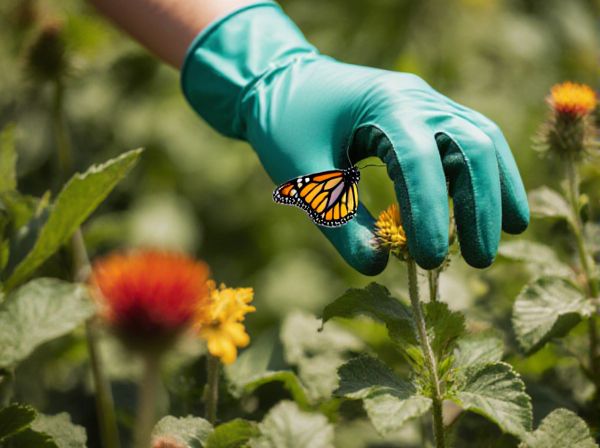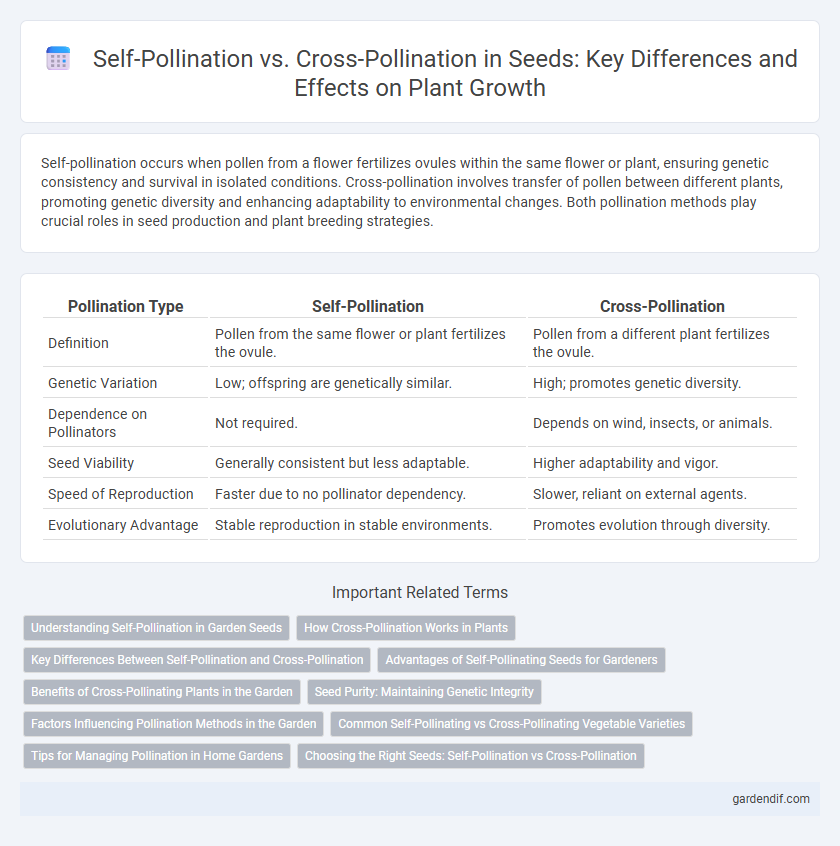
Self-pollination vs Cross-pollination Illustration
Self-pollination occurs when pollen from a flower fertilizes ovules within the same flower or plant, ensuring genetic consistency and survival in isolated conditions. Cross-pollination involves transfer of pollen between different plants, promoting genetic diversity and enhancing adaptability to environmental changes. Both pollination methods play crucial roles in seed production and plant breeding strategies.
Table of Comparison
| Pollination Type | Self-Pollination | Cross-Pollination |
|---|---|---|
| Definition | Pollen from the same flower or plant fertilizes the ovule. | Pollen from a different plant fertilizes the ovule. |
| Genetic Variation | Low; offspring are genetically similar. | High; promotes genetic diversity. |
| Dependence on Pollinators | Not required. | Depends on wind, insects, or animals. |
| Seed Viability | Generally consistent but less adaptable. | Higher adaptability and vigor. |
| Speed of Reproduction | Faster due to no pollinator dependency. | Slower, reliant on external agents. |
| Evolutionary Advantage | Stable reproduction in stable environments. | Promotes evolution through diversity. |
Understanding Self-Pollination in Garden Seeds
Self-pollination in garden seeds occurs when pollen from the same flower or another flower on the same plant fertilizes the ovule, ensuring genetic consistency in offspring. This natural process reduces the dependency on external pollinators and maintains stable plant traits, making it ideal for preserving specific seed varieties. Understanding self-pollination helps gardeners select plants for reliable seed production and consistent garden performance.
How Cross-Pollination Works in Plants
Cross-pollination occurs when pollen from the anther of one plant fertilizes the stigma of a flower on a different plant, promoting genetic diversity. Pollinators such as bees, butterflies, and wind play a critical role in transferring pollen between plants, ensuring successful reproduction. This process increases the adaptability and resilience of plant species by combining diverse genetic traits from separate individuals.
Key Differences Between Self-Pollination and Cross-Pollination
Self-pollination occurs when pollen from the same flower or plant fertilizes the ovule, resulting in limited genetic variation but consistent traits, while cross-pollination involves the transfer of pollen between different plants, promoting genetic diversity and adaptation. Self-pollination is common in plants like peas and wheat, whereas cross-pollination is prevalent in many fruit and vegetable species such as apples and maize. Key differences include the source of pollen, impact on genetic diversity, and reliance on pollinators or environmental factors for pollen transfer.
Advantages of Self-Pollinating Seeds for Gardeners
Self-pollinating seeds ensure genetic consistency, providing gardeners with uniform plant traits and reliable crop quality. They minimize dependency on pollinators, making them ideal for controlled environments or regions with limited insect activity. This enhances seed saving efficiency, allowing gardeners to propagate true-to-type plants across growing seasons.
Benefits of Cross-Pollinating Plants in the Garden
Cross-pollinating plants increase genetic diversity, leading to stronger disease resistance and improved adaptability to environmental changes. This process enhances fruit and seed quality, often resulting in higher yields and better nutritional value. Gardeners benefit from robust plant growth and greater resilience through promoting cross-pollination among diverse plant species.
Seed Purity: Maintaining Genetic Integrity
Self-pollination ensures seed purity by preserving genetic integrity through fertilization within the same flower or plant, minimizing genetic variation. Cross-pollination introduces genetic diversity but risks contamination of seed stock, potentially compromising uniformity and crop consistency. Maintaining strict control over pollination methods is crucial for seed producers aiming to deliver genetically stable and true-to-type seed varieties.
Factors Influencing Pollination Methods in the Garden
Seed development in the garden is influenced by factors determining self-pollination or cross-pollination efficacy, such as flower structure, pollinator availability, and environmental conditions like wind and humidity. Plants with closed or tubular flowers tend to favor self-pollination, while open flowers with accessible nectar attract pollinators, promoting cross-pollination. Soil quality and plant diversity also impact pollination success by supporting healthy pollinator populations and facilitating pollen transfer.
Common Self-Pollinating vs Cross-Pollinating Vegetable Varieties
Common self-pollinating vegetable varieties include tomatoes, peas, and beans, which produce seeds that maintain genetic consistency across generations. Cross-pollinating vegetables such as carrots, cucumbers, and cabbage rely on external agents like insects or wind to transfer pollen, resulting in greater genetic diversity. Understanding the pollination mechanism is crucial for seed saving and maintaining varietal purity in home gardens and commercial farming.
Tips for Managing Pollination in Home Gardens
To manage pollination effectively in home gardens, plant self-pollinating species close together to ensure consistent fruit production without relying on external pollen sources. Encourage cross-pollination by introducing diverse plant varieties and attracting pollinators like bees through native flowers and minimizing pesticide use. Regularly monitor flowering times and plant health to optimize pollination success and improve seed quality.
Choosing the Right Seeds: Self-Pollination vs Cross-Pollination
Choosing the right seeds depends on understanding the differences between self-pollination and cross-pollination. Self-pollinating seeds, like tomatoes and peas, produce plants with stable traits and uniform crops, ideal for consistent yield and seed saving. Cross-pollinating seeds, found in crops such as corn and squash, encourage genetic diversity, which can lead to greater resilience and adaptability in changing environments.
Self-pollination vs Cross-pollination Infographic

 gardendif.com
gardendif.com